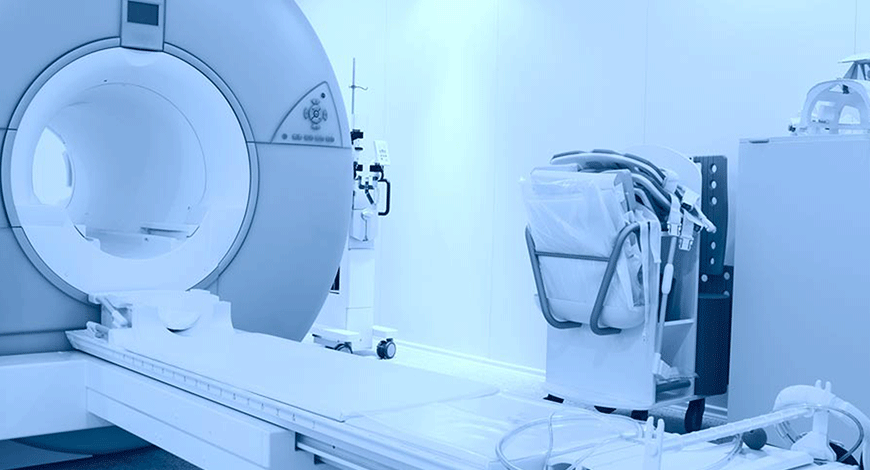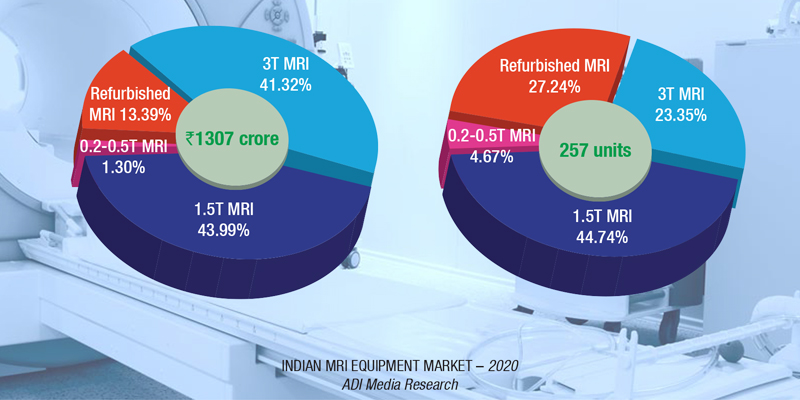MRI Equipment
Diagnosing the long-term effects of COVID-19

MRI gained relevance as COVID-19 spread across countries, as the modality helped clinicians and researchers monitor patient recovery and search for the underlying causes of lasting COVID-19 symptoms.
Patients hospitalized with COVID-19 have been commonly left with lingering symptoms, sometimes for months and longer, after negative COVID-19 tests. It is the MRI that then helps clinicians and researchers understand why and how symptoms evolve.
The global MRI market is diversifying, driven by various factors including point-of-care, pediatrics, dry-magnets, compact MRI, and fusion imaging. Yet, a trend toward privatization is gaining momentum: Growing public-private partnerships and an increase in near-replacement time in public domains are expected to attract more MRI system procurements.
The MRI equipment worldwide market is expected to grow from USD 6.2 billion in 2020 to USD 7.8 billion by 2025 with a compound annual growth rate (CAGR) of 4.8 percent.
The open MRI segment will continue to diminish with wider adoption of 1.5T and 3T MRI systems that incorporate increased field of view and radiofrequency (RF) channels, and enhanced signal-to-noise ratio, optimizing patient throughput with improved static and dynamic imaging capabilities and artificial intelligence (AI)-augmented technical features. The commercialization of portable MRI is expected to increase dramatically in the mid to long term. The inclusion of technologies that improve workflow, portability, and the ability to cater to various applications are competitive factors driving the market. From a market segment perspective, high-field and extremity MRI are vital contributors to the total MRI market, garnering revenue at a CAGR of 8.5 percent.
The Indian MRI equipment market for 2020 is estimated at ₹1307 crore, and 257 units, by volume. This is an 11-percent decline in volume and a 26-percent decline in value over 2019. This may be explained by a slight drop in the unit price of 3T and 1.5T systems, and an increase in demand for the refurbished systems in the overall pie.

The premium systems – 3T and 1.5T – continue to dominate the market with a combined 85-percent share by value. These two segments each contribute about 42 percent by value, albeit by volume 1.5T sells almost twice than 3T systems. The refurbished machines in 2020 saw an increase over 2019, defying the trends of 2019 and 2018, when they had, in spite of declining prices, been stagnant. This estimate includes 12 percent GST and third-party items, which amount to approximately 8 percent of the price of the equipment.
The segment continues to be dominated by Siemens, GE, and Philips. Toshiba and Hitachi are the other brands with some presence.
|
Indian MRI equipment market |
||
|
Major vendors* – 2020 |
||
| Tier I | Tier II | Others |
| Siemens, GE, and Philips | Toshiba and Hitachi | Esaote |
| *Vendors are placed in different tiers on the basis of their sales contribution to the overall revenues of the Indian MRI equipment market. | ||
| ADI Media Research | ||
The decline in the market is attributed solely to the pandemic. It is expected that by end-2021, the sector will be back on track. As per the trend, large hospitals and the government, in spite of budgetary pressure, are not expected to compromise on quality and will continue to buy the high-end machines. It is the PPP medical facilities that make do with the low-end and refurbished models. By brand, Philips is quite successful with government hospitals, whereas GE’s focus is on the private sector.
Mild or moderate COVID-19 lasts about two weeks for most people. But others experience lingering health problems even when they have recovered from the acute phase of the illness. Healthcare providers are uncovering more and more documented cases, where recovered COVID-19 patients show long-term effects from the disease in the lungs, heart, immune system, brain, and other organs.
CT has become an important clinical diagnostic tool in highly suspected COVID-19 cases in an early stage. And other imaging modalities like MRI come into play as clinicians monitor patient recovery and search for the underlying causes of lasting COVID-19 symptoms.
Patients recovered from COVID-19 could lead to long-term symptoms. MRI helps clinicians and researchers understand why and how symptoms evolve. A number of new projects are underway to help understand the underlying causes of these lasting symptoms, which can include fatigue, shortness of breath, as well as difficulty concentrating or memory problems.
Despite the spread of the pandemic, innovation has been ongoing in the MR community with powerful new technologies, as well as AI-based solutions, so that radiology can lead the way in understanding these important clinical issues with respect to COVID-related diseases and lingering symptoms.
Cardiac MR can be used to monitor a number of different heart-related conditions and changes in actively infected, as well as post-infection COVID-19 patients. Cardiac MR provides a radiation-free alternative to other modalities, such as CT and SPECT, commonly used for cardiac evaluation, and it provides accurate anatomic information along with advanced soft tissue contrast.
Cardiac MR also offers greater contrast and image clarity than CT. Recent advances in cardiac MR have allowed for faster acquisition times and easier breath-hold sequences for patients. It is recognized as a valuable clinical tool, which in a single scan setting can not only perform myocardial perfusion imaging but can also assess ventricular volumes and function, myocardial fibrosis, iron loading, flow quantification, and tissue characterization.
Cardiac MR for determining cardiac involvement in actively infected COVID-19 patients is crucial for their immediate and now longer-term prognosis. The continued use of cardiac MR can identify COVID-19 patients with possible cardiac injury and help predict progression of disease-related complication.
Research is now suggesting that there may be long-term neurologic consequences in patients, who survive COVID infections, including evidence of mild brain damage in many survivors. Recent advances in neuro MR imaging, using ultra-high field MR scanners, enable neuroimaging with unprecedented detail, leading to better characterization of normal tissue and pathologic lesions and improved planning of treatment and monitoring of response. The promise of ultra-high-field MR imaging to evaluate post-COVID-19 patients for long-term neurological manifestations took a significant step forward.
According to data gathered by clinicians from all parts of the world, brain abnormalities have emerged as a major feature of COVID-19 and contribute to the growing concerns about central nervous system involvement in COVID-19. Some of the neurologic consequences of COVID-19 that have been observed can be broadly grouped into four categories – direct viral effects through neuro-invasion, meaning when the virus enters the brain directly by crossing the blood brain barrier; para-infectious immune response to the virus that manifests as coagulopathy (impaired clot formation) or as a cytokine storm, meaning when the body initiates a hyperactive immune response to the virus, to the extent it can be harmful to host cells; post-infectious delayed immune response; and complications of prolonged illness or hospitalization. The ability for ultra-high-field MRI to identify and track these and other neurologic manifestations related to COVID-19 infection is critically important as evidential data continues to be collected about the long-term cognitive effects of COVID-19 on infection survivors.
According to clinicians, post-acute COVID-19 or long COVID is a multisystem disease that occurs after COVID-19 infection and requires follow-up clinical care with a whole patient perspective. To adequately monitor the long-term health of these patients and to collect the outcomes data necessary to formulate scientific conclusions about the clinical impacts from COVID-19 infection, longitudinal MRI evaluations of critical organs, such as heart, brain and lungs should be completed as required. The MRI community is supportive of these efforts and continues to advance imaging techniques for assessing organ function as well as AI-enabled solutions for image reconstruction to understand the long-term clinical impact of COVID-19.














